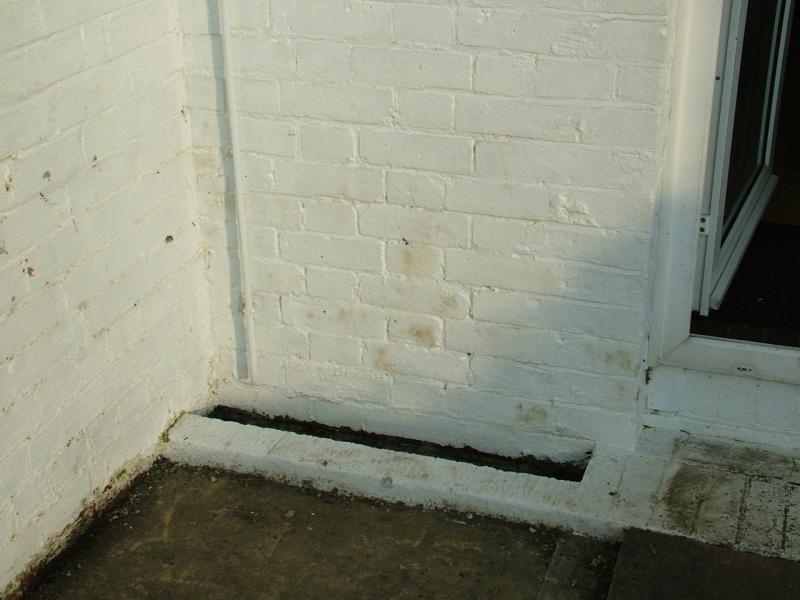I have some “damp marks” on the lower outside face of the rear of my house, which I think might be coming from an attached boundary retaining wall.
My house is a 1920’s terraced house on a hill road. My neighbours’ house is set 9 bricks higher than mine and at the rear of our houses there is a single brick thick retaining wall on the boundary between our back gardens (the wall used to be the “party wall” of back-to-back coal bunkers). The ground area on my side of the retaining wall has been concreted over and likewise on my neighbour’s side about 490 mm higher.
My first thought is that the damp is coming from the retaining wall. This wall is attached to the rear exterior wall of my house (it was built like that) and I imagine it is drawing moisture from the higher ground behind it and “wicking” it into the rear wall of my house. Strangely I see no damp marks on the retaining wall itself although there are signs of efflorescence. Inside the house, this corner is largely hidden by kitchen worktops/cupboards and I can see only slight visual indications of dampness.
A complication is that the rear step of my backdoor bridges the DPC (I blame this on previous owner’s DIY) and this I intend to rectify. However, I don’t think this is a major contribution to the damp marks because I see no such marks on the other side of the back door.
My question(s):
Where do you think the damp is coming from and can I do anything about it, short of digging up next-doors patio area of course?
The existing concrete surface is slightly above the house DPC and a gap has been left between the concrete and the rear of the house to avoid bridging. The concrete extends right against the retaining wall and, even though I can see no DPC here, would it be worth my while cutting a similar gap?
Would it be worthwhile considering injecting (I’ve seen this advertised) a vertical DPC right in the corner between the rear of my house and the retaining wall?
Keith
My house is a 1920’s terraced house on a hill road. My neighbours’ house is set 9 bricks higher than mine and at the rear of our houses there is a single brick thick retaining wall on the boundary between our back gardens (the wall used to be the “party wall” of back-to-back coal bunkers). The ground area on my side of the retaining wall has been concreted over and likewise on my neighbour’s side about 490 mm higher.
My first thought is that the damp is coming from the retaining wall. This wall is attached to the rear exterior wall of my house (it was built like that) and I imagine it is drawing moisture from the higher ground behind it and “wicking” it into the rear wall of my house. Strangely I see no damp marks on the retaining wall itself although there are signs of efflorescence. Inside the house, this corner is largely hidden by kitchen worktops/cupboards and I can see only slight visual indications of dampness.
A complication is that the rear step of my backdoor bridges the DPC (I blame this on previous owner’s DIY) and this I intend to rectify. However, I don’t think this is a major contribution to the damp marks because I see no such marks on the other side of the back door.
My question(s):
Where do you think the damp is coming from and can I do anything about it, short of digging up next-doors patio area of course?
The existing concrete surface is slightly above the house DPC and a gap has been left between the concrete and the rear of the house to avoid bridging. The concrete extends right against the retaining wall and, even though I can see no DPC here, would it be worth my while cutting a similar gap?
Would it be worthwhile considering injecting (I’ve seen this advertised) a vertical DPC right in the corner between the rear of my house and the retaining wall?
Keith


